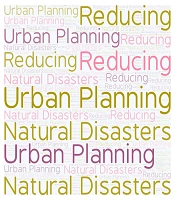Dear Editor,
The development of societies and the complications of internal relations of societies has increased the number of crises caused by natural and man-made disasters. Disasters have consequences that delay economic and social development, etc., for years (1). One of the significant aspects of development planning is paying attention to the vulnerability of cities as the most important manifestation of development in the country against natural disasters (2).
The city is a human, social, cultural, economic, and physical phenomenon. The building is one of the physical elements of the city (3). It is very difficult and costly to apply building principles resistant to all kinds of disasters, and in most cases, standard and appropriate measures are not taken (4).
Natural disasters, such as floods and earthquakes, have often left devastating effects on human settlements and caused heavy losses to their inhabitants; it has destroyed buildings and infrastructure and imposed widespread economic and social consequences on communities and countries (5). The vulnerability of human settlements to natural disasters has increased due to population concentration and economic activities in dense areas, poor housing conditions, and low-income residents in urban and rural areas. The extent of damage that a disaster cause does not depend only on its destructive power. This rate depends on the condition of the infrastructure structures exposed to the disaster. In many countries, the population of slums and suburbs has increased with the extreme concentration of the population, so in these areas, a small natural disaster can be catastrophic (6).
The starting point of modern urban planning was formed in the 19th century with medical advances and planning for the health of society (2). The disadvantages of these two disciplines were separated from each other. The consequence of this separation is the reduction of the importance of health in urban decision-making. In recent years, the effect of location on health has been investigated due to necessity. However, there is still an integrated structure for the place of health in urban planning. The goal of improving citizens' quality of life and health is not defined (7). Urban planning is a science that is closely related to crisis management in order to reduce urban damage. By applying the principles and rules of urban planning and explaining the concepts in this knowledge, such as the form, texture, and construction of the city, land use, urban hierarchy, communication networks, and urban infrastructures, etc., the effects and consequences caused by accidents can be greatly reduced (4).
In general, urban planning in the following ways can be effective in disaster management and prevention:
A. Geological and geomorphological conditions of urban infrastructure: Important and active faults in the vicinity of buildings and facilities should be recognized, and a specific area for faults should be considered in the location of land uses (3).
B. Topography and slope: The damage's severity is higher in mountainous areas and steep slopes. In general, the slope threshold of 15% increases the rate of casualties (8).
C. Physical and structural variables: Physical and structural variables, including the network of roads, distribution of land uses, proximity of land uses, building density and strength, etc., determine the degree of resistance to risk. Creating a relative dispersion in different types of land use causes population dispersion in the city and effectively reduces the rate of losses (9).
D. Determining the area of the old texture of cities: Planning and protecting this vulnerable area from disasters.
E. Raising public awareness about the effects of disasters and how people can participate in reducing their impacts
Urban planning attempts to formulate principles to create a physical environment suitable for living. One of the ways to deal with and reduce the risks of urban disasters in human societies is to follow the appropriate location pattern. It should be noted that not paying attention to the correct location creates many problems and suffering. Lack of attention to the location of cities and villages, their location and growth on faults and rivers cause a lot of material and human losses. For the settlement of the urban population, with the destruction of agricultural lands, natural areas have been turned into residential houses, which has caused seasonal floods.
